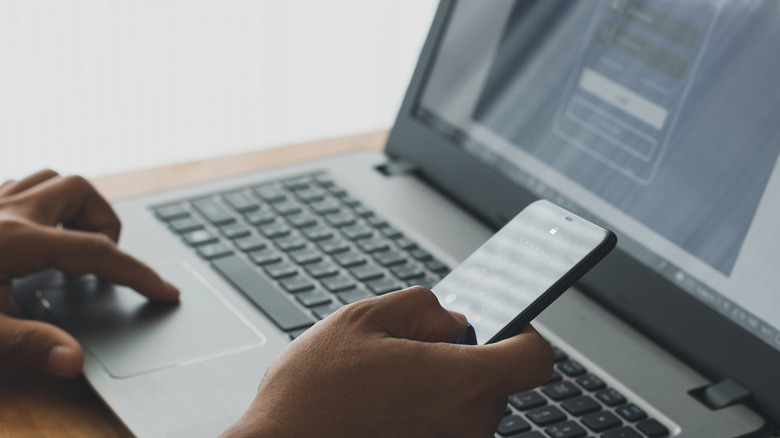The Biggest Email Mistakes You Could Be Making At Work
If you work in the corporate world, you are definitely familiar with email. And even if you make a career change — whether it is to cope with a bad boss or you have experienced one too many employer red flags — you probably won't escape the drudgeries of the email. We spend hours — yes, the plural hours — on our email each work day. A 2018 study found that U.S. workers spend about three hours clicking through their work emails. Though emailing may feel like a bit of a chore, paying attention to your inbox is 100% worth it.
This is especially important for those just entering the workforce. While we learn many things throughout our education, lots of us are left to figure out email etiquette all on our own. Knowing the best email practices can ensure smooth communication in the workplace and avoid people perceiving your words as passive-aggressive.
With the importance of email etiquette in mind, here are the mistakes you must avoid when communicating professionally online.
Not including a greeting
A study by the language-learning platform Preply revealed some of the most annoying emailing habits, per Real Simple. Specifically, the site asked what email greetings were the worst. The answer? No greeting at all. People find that jumping straight to the point without any form of greeting comes off as aggressive. Paying attention to how your voice via email sounds is important. According to Preply's study, 91% of workers felt that fellow employees were at some point passive-aggressive over email.
So what should you say? The study cites "Hiya" as the second-most disliked greeting and the name plus colon (for instance, "Marie:") as number three. Experts and business executives told Insider that the best email greeting was the simple: "Hi [insert name]." Not too formal, quick, and able to confirm that this email was indeed meant for you, this is the ideal way to greet co-workers and bosses via email.
Sending emails to people who don't need them
Many of us roll our eyes and groan at the sight of an ever-growing email inbox. As noted above, parsing through emails at work takes up a significant chunk of our time. Don't be an extra email in someone's inbox if your message isn't tailored toward them. Harvard Business Review advises employees to think specifically about whose attention and time they need. Some people will need to know more information about a project than others. And no: your boss doesn't need to be CC'd on every single work email (unless for some masochistic reason they just really love email).
Harvard Business Review recommends avoiding sending messages to an entire team when one or two point people are the only ones who need the update. When it comes to CC'ing people, the service Spike suggests using it to keep others in the loop (so long as you avoid micro-managing them).
Having a vague subject line
It goes to say that if you have a limited amount of time and a seemingly endless stream of emails in your inbox, you will need to work through the most important ones first. If you want others to actually pay attention to your email and the information it contains, show a sense of importance within the subject line.
According to TheLadders, the number one best practice for writing an email subject line is to keep it brief. Though you don't want to be long-winded, you must include enough words to get your intended reader's attention. With that, relevancy is key. Don't include unnecessary information in your subject line. Another tip to increase the likelihood that the person looking at their screen will open your email? Personalize your subject line. A study showed that open rates increased by nearly 30% when subject lines included a personal element like the words "you" and "me."
Not identifying deadlines
When urgency is at issue, make it known. Making some form of a project timeline available for your team can make the work process significantly smoother, according to Forbes. Keeping your co-workers aware of their deadlines will make sure that your project gets done on time. If you are communicating about it via email, be sure to include the date you need something done. While this may seem aggressive, setting deadlines for a response or action to be taken will clear any confusion.
Harvard Business Review has a few suggestions for easy ways to include a timeline in your email: "Could you please fill out this survey by Friday, July 15 at 3 pm?" and "Can you please gather the data we discussed for a 10 am meeting on Monday, August 10?" are great templates for setting deadlines without coming off as aggressive. Overall, highlighting deadlines is a way to help everyone stay on the same page.
Writing emails that are too long
Emails are all about efficiency. If your coworker wanted an inefficient form of communicating with you about work details, they would train a pigeon to carry a letter to your office. (A bad deal for you, your officemates, and probably the pigeon.) Keep your emails brief, explaining as much as you need without going on and on and on and...you get the point.
"Emails should be efficient and to the point," said national etiquette expert Diane Gottsman (via Good Housekeeping). Don't waste your reader's time by including too much detail or including too many points. Grammarly advises email writers to have a goal for each email in mind. When you find yourself repeating points, hit the "delete" button. And—though we want to uphold good workplace friendships—consider keeping pleasantries and small talk in your emails at a minimum.
While emailing can be annoying, it is a vital part of the workplace. Communication keeps everything going in the office. If you avoid these email mistakes, you are sure to save everyone valuable time and energy.





